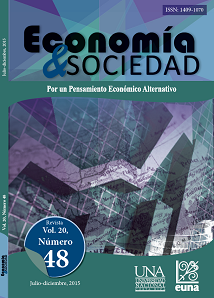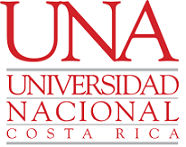¿Cuáles son las condiciones que generan el éxito micro-financiero?
DOI:
https://doi.org/10.15359/eys.20-48.4Palavras-chave:
Determinantes del desarrollo, desarrollo humano, microcréditos, pobrezaResumo
En este trabajo nos aproximaremos al estudio de las causas del desarrollo desde aquellos elementos que hacen de la micro-financiación una herramienta efectiva en la erradicación de la pobreza. La eficacia de tal instrumento en la generación de riqueza a las clases más empobrecidas exige superar el marco minimalista de actuación que condena sus prácticas a la mera provisión de servicios microfinancieros. Esta proposición será corroborada analítica y empíricamente desde la asimilación del desarrollo humano como causa y no solo resultado del éxito microfinanciero. Para ello diseñamos dos rectas de regresión donde variables como la educación, sanidad y seguridad alimentaria mostrarán ser determinantes a la hora de explicar el comportamiento en los ingresos de los beneficiarios de tales programas microfinancieros.
Referências
Acemoglu, D., & Robinson, J. (2012). Why Nations Fail. The Origins of Power, Prosperity and Poverty. Retrieved from https://books.google.co.cr/books?id=yIV_NMDDIvYC&redir_esc=y
Aghion, B., & Morduch, J. (2003). The Economics of Microfinance. Cambridge: the MIT Press.
Arcand, J. & Faye, I. (2002). Health and Economic Growth: Findings and Policy Implications. Retrieved from http://www.upf.edu/pdi/cres/lopez_casasnovas/_pdf/health_economic.pdf
Banerjee, A., Vinayak, A., & Duflo, E. (2011). Poor Economics: A Radical Rethinking of the Way to Fight Global Poverty. Retrieved from https://books.google.co.cr/books?id=Tj0TF0IHIyAC&redir_esc=y
Besley, T. & Coate, S. (1993). The Economics of rotating savings and credit associations.American Economic Review, 3(83), 792-810.
Bruhn, E., & Love, I. (2009). The Economic Impact of Banking the Unbanked.Evidence from Mexico.http://dx.doi.org/10.1596/1813-9450-4981
Cohen, M. & Nelson, C. (2011). Financial literacy: A step for clients towards financial inclusion (Commissioned Workshop Paper). Retrieved from http://citeseerx.ist.psu.edu/viewdoc/download?doi=10.1.1.466.2029&rep=rep1&type=pdf
De la Cruz, N., Crookston, B., Gray, B., Alder,S., &Dearden, K. (2009). Microfinance against malaria: impact of Freedom from Hunger’s malaria education when delivered by rural banks in Ghana. Transactions of the Royal Society of Tropical Medicine and Hygiene, 103(12), 1229-1236. http://dx.doi.org/10.1016/j.trstmh.2009.03.018
Devoto, F., Duflo, E., Dupas, V., & Pouliquen, V. (2011). Turning a Shove into a Nudge? A Labeled Cash Transfer for Education (Working Paper No.19227) Retrieved from web site of The National Bureau of Economic Research: http://www.nber.org/papers/w19227
Field, E. & Pande, R., (2007). Repayment Frequency and Default in Micro-Finance: Evidence from India. Retrieved from http://www.hks.harvard.edu/fs/rpande/papers/repayfreqjeea_1107.pdf
Fisher, T. & Sriram, M., (2002). Beyond micro-credit: Putting development back into micro-finance. Retrieved from https://books.google.co.cr/books/about/Beyond_Micro_credit.html?id=jfBnBtxmPUwC&redir_esc=y
Gallup, J. & Sachs, J. (2001). The Intolerable Burden of Malaria: A new look at the numbers. The American Journal of Tropical Medicine and Hygiene, 64(1). Retrieved fromhttp://www.ncbi.nlm.nih.gov/books/NBK2624/
Ghatak, M. & Guinnance, T. (1999). The Economics of lending with joint-liability: theory and practice. Journal of Development Economics, 60(1), 195-228. http://dx.doi.org/10.1016/S0304-3878(99)00041-3
Giné, X. & Karlan, D. (2007). Group versus Individual Liability: A Field Experiment in the Philippines. Retrieved from http://www-wds.worldbank.org/external/default/WDSContentServer/WDSP/IB/2006/09/18/000112742_20060918174212/Rendered/PDF/WPS40081IE70B3111130ADDITIONAL0COTITL.pdf
Jimenez, A. (2013). Economía del desarrollo humano y microfinanciacion. Una aproximación a los determinantes del Microcrédito. (Tesis doctoral inédita, Universidad de Sevilla).Retrievedfromhttp://fondosdigitales.us.es/tesis/tesis/2078/economia-del-desarrollo-humano-y-microfinanciacion-una-aproximacion-los-determinantes-de-microcredito/
Karlan, D., & Zinman, J. (2009). Expanding Microenterprise Credit Access: Randomized supply decisions to estimate impacts in Manila (Economic Department Working Paper, Nº68). Yale University. Retrieved from web site Department of Economics Yale University: http://economics.yale.edu/sites/default/files/files/Working-Papers/wp000/ddp0068.pdf
Karlan, D., & Valdivia, M. (2011). Teaching Entrepreneurship: Impact of Business Training on Microfinance Clients and Institutions.The Review of Economics and Statitics, 93(2), 510-527.http://dx.doi.org/10.1162/REST_a_00074
Khandker, S. (1998). Does Microfinance really benefit the poor? Evidence from Bangladesh, paper delivered at Asia and Pacific Forum on Poverty: Reforming policies and institutions for poverty reduction.Held by the Asian Development Bank. Retrieved from http://pdf.wri.org/ref/morduch_02_analysis_effects.pdf
Landes, D. (1999). The Wealth and Poverty of Nations. Why are some so rich and some so poor. Retrieved from https://books.google.co.cr/books/about/The_Wealth_and_Poverty_of_Nations_Why_So.html?id=A6JPn5zAR1AC&redir_esc=y
Leatherman, S., Dunford, C.,Metcalf, M.,&Reinsch, M.(2011).Integrating Microfinance and Health.Benefits, Challenges and Reflections for moving forward. Retrieved from http://www.microcreditsummit.org/resource/38/integrating-microfinance-and-health-benefits.html
Leive, A. & Xu, K. (2008). Coping with Out-of-Pocket Health Payments: Empirical Evidence from 15 African Countries.Bulletin of the World Health Organization, 86(11), 849-56. Retrieved from http://www.who.int/bulletin/volumes/86/11/07-049403.pdf
Maniruzzama, M. & Rutherford, S. (1998). Exploring Client Preferences in Microfinance.The Consultative Group to Assist the Poorest.
McIntosh, C. & Wydick, B. (2002). Competition and Microfinance.Working Paper, Berkeley, University of San Francisco.Retrieved form http://repository.usfca.edu/cgi/viewcontent.cgi?article=1019&context=econ
MkNelly, B., &Dunford, C. (1998). Impact of credit with education on mothers and their Young children´s Nutrition: Lower Rural Bank Credit with Education Program in Ghana. (Research Paper No.4). Retrieved from web site Freedom from Hunger: https://www.freedomfromhunger.org/impact-credit-education-mothers-and-their-young-children%E2%80%99s-nutrition-lower-pra-rural-bank
Montgomery, H. (2005). Serving the Poorest of the poor: The poverty impact of the Khushhali Bank´s Microfinance Lending in Pakistan.Retrieved fromhttp://www.adb.org/publications/serving-poorest-poor-poverty-impact-khushhali-banks-microfinance-lending-pakistan
Nanor, M. (2008). Microfinance and its impact on selected districts in Eastern Region of Ghana.Final Dissertation. Retrieved fromhttp://ir.knust.edu.gh/handle/123456789/598
Nelson, L. (2011). From Loans to Labour: Access to Credit, Entrepreneurship and Child Labour. Mimeo. Retrieved from http://www.colorado.edu/Economics/seminars/SeminarArchive/2011-12/Nelson.pdf
United Nations Development Programme (1994). Human Development Report 1994.Retrieved fromhttp://hdr.undp.org/en/content/human-development-report-1994
United Nations Development Program (2012). Concept and measurement of Human Development 2012.Retrieved from http://hdr.undp.org/en/reports/global/2000?page=1
Robinson, M. (2004). La Revolución Microfinanciera. Finanzas sostenibles para los pobres.Retrieved fromhttp://www-wds.worldbank.org/external/default/WDSContentServer/WDSP/IB/2007/05/11/000020953_20070511133803/Rendered/PDF/232500v10SPANI1180015721X001PUBLIC1.pdf
Rogers, H., & Stern, N. (2005). Growth and Empowerment: Making Development Happen. Retrievedfromhttps://mitpress.mit.edu/books/growth-and-empowerment
Sadoulet, L. (2003). The role of mutual insurance in group lending.Draft, ECARES, Free University.Retrived from http://www.researchgate.net/publication/247985788_The_Role_of_Mutual_Insurance_in_Group_Lending
Smith, A. (2007). An Inquiry into the Nature and Causes of the Wealth of Nations. Retrieved from http://www.ibiblio.org/ml/libri/s/SmithA_WealthNations_p.pdf
Todd, H. (1996). Women at the center: Grammer Bank borrowers after one decade. Retrieved from http://uplbooks.com.bd/book/women-center-grameen-bank-borrowers-after-one-decade
Yunus, M. (2001). Banker of the Poor: The Autobiography of Muhammad Yunnus, Founder of the Grammer Bank. Retrieved from http://www.amazon.com/Banker-Poor-Autobiography-Muhammad-Founder/dp/0195795377
Yunus, M. (2010). Building Social Business. The New Kind of Capitalism that serve humanity´s most pressing needs. Retrieved from https://books.google.co.cr/books?id=W0EDHD28NB8C&redir_esc=y
Downloads
Publicado
Como Citar
Edição
Seção
Licença
This publication is subject to the Creative Commons License; therefore, its attributions and restrictions must be respected.
Authors publishing in this Journal accept the following conditions:
- Authors retain copyright ownership and give the Journal first publication right of the paper, which is registered with the Creative Commons Attribution-NonCommercial-ShareAlike 4.0 International License. This license allows third parties to use the published work provided it is sourced as firstly published in this Journal.
- Authors may enter into other independent and additional contractual agreements for the non-exclusive distribution of the article published in this Journal (e.g., to be included in an institutional repository or published in a book) provided it is clearly stated that the work was published in this Journal for the first time.
- Authors are allowed and recommended to publish their work on the Internet (for example, on institutional or personal pages) before and during the review and publication process, as it can lead to productive exchanges and a greater and faster dissemination of work published.

The Economía & Sociedad Journal, published by Universidad Nacional, is licensed under a Creative Commons Reconocimiento-NoComercial-CompartirIgual 4.0 Internacional License. Based on http://www.revistas.una.ac.cr/index.php/economia.








